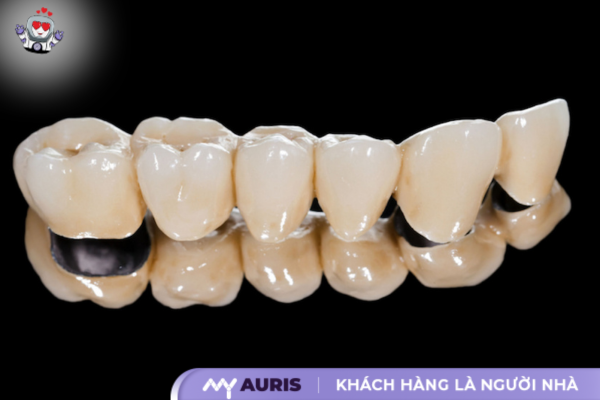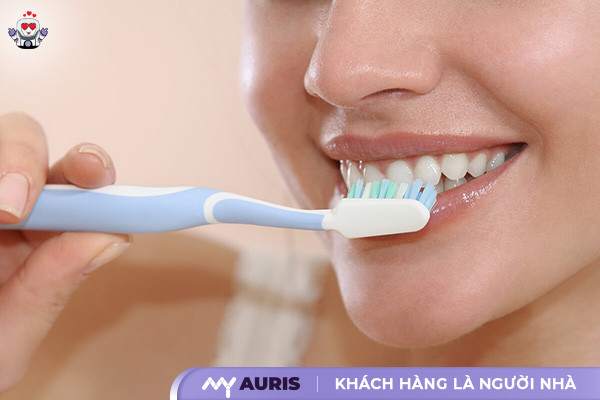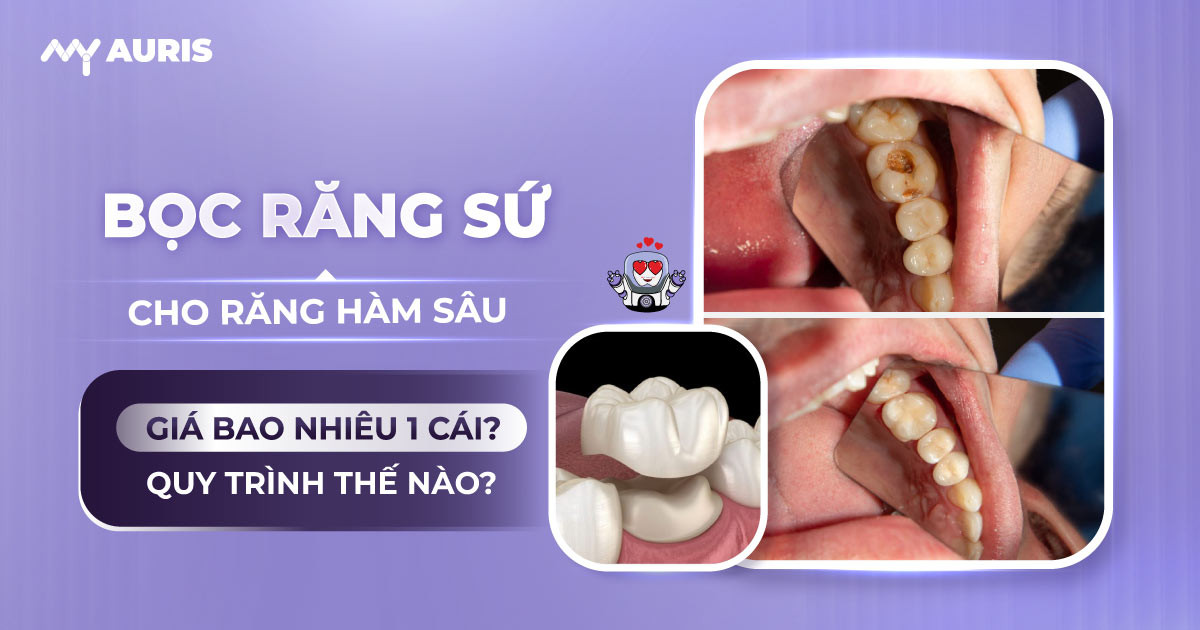Tooth decay is one of the common dental problems that anyone can encounter. When this condition becomes severe, dental fillings may no longer provide optimal results. At this time, porcelain crowns are a restoration solution that needs to be considered. So when should you get porcelain crowns for cavities? How much does porcelain dental crown cost? The article below will help you better understand this method, from the benefits to the implementation process, helping to optimally protect oral health.
Ceramic crowns for cavities: the ultimate solution pros?
Whether porcelain crowns for cavities can be done depends on the level of damage to the tooth. If the tooth is in the early stages of decay, the cavity is small and has not affected the pulp, the tooth filling method will be the optimal solution to restore the original shape and maintain the chewing function.
However, when the tooth is severely decayed, the cavity is large or the tooth has dead pulp, the usual tooth filling method is no longer effective. At this time, porcelain crowns are the optimal solution to preserve real tooth roots, protect teeth from bacteria, help strengthen teeth and prolong life. Porcelain crowns are a technique in which the doctor grinds a portion of the real tooth pulp, creating space for a porcelain crown to be placed on top. Porcelain crowns will fit tightly to the tooth pulp, covering the entire tooth surface to restore decayed and damaged teeth.
So can severely decayed teeth be covered with porcelain? In cases where the tooth is severely decayed, bacteria have penetrated into the pulp, causing most of the tooth’s crown to be lost or the tooth’s root has become loose, the doctor may prescribe tooth extraction. At that time, alternative methods such as implants or porcelain bridges will be applied to ensure chewing function and aesthetics.
To know the exact condition of your cavities that can be covered with porcelain or not, you need to go to the dentist for a direct examination by a doctor. After thoroughly examining the level of tooth decay, your doctor will advise you on the most suitable treatment plan to help you maintain optimal oral health.

Why do cavities need porcelain crowns?
Molar teeth play an important role in the body. They are responsible for chewing and crushing food. Decayed molars seriously affect oral health, the whole body, and even psychology. Porcelain crowns are a solution to restore decayed molars, bringing many benefits.
Tooth decay starts from a small hole on the tooth surface. Bacteria in the mouth attack real teeth, creating acid. Acid destroys tooth enamel, dentin, and finally the tooth pulp. Cavities in molars cause pain and discomfort when chewing. If not treated promptly, tooth decay progresses to pulpitis, even tooth loss. Tooth extraction is the last solution, affecting chewing function, aesthetics, and can cause bone loss. jaw.
Ceramic dental crowns for cavities are a cosmetic dental restoration method, using porcelain shells with the same color and shape as real teeth to surround the tooth pulp, protecting the real tooth from bacteria, acids, and other harmful agents. Porcelain crowns help restore chewing function and improve aesthetics. bring a confident smile.
Popular types of porcelain teeth for cavities
Decay molars greatly affect oral health and function. chewing. Restoring teeth with porcelain crowns is a conservative treatment solution, restoring chewing function and improving aesthetics. So, which type of porcelain tooth should you choose for decayed molars? id=”Rang_Su_Kim_Loai”>Metal Porcelain Teeth
Metal ceramic teeth consist of an inner metal frame and an outer porcelain layer. The advantage of this type is that the dental cost is lower than that of all-ceramic teeth. However, it has a disadvantage is not very aesthetic. Over time, the gum line may darken due to the metal inside. Some patients with metal allergies will not be biologically compatible with this type of ceramic crown. The technique of making metal porcelain crowns is also simpler than that of all-ceramic teeth. class=”wp-caption aligncenter”> All-ceramic teeth are made entirely from ceramic material, containing no metal. The outstanding advantages are high aesthetics, natural color like real teeth, good fit. High biocompatibility, does not irritate the gums, does not darken the gum line. All-ceramic teeth have a long life, good bearing capacity thanks to modern manufacturing technology such as CAD/CAM technology. However, dental costs for teeth All-ceramic teeth are usually higher than metal-ceramic teeth. Here are some popular types of all-ceramic teeth: Choosing the right type of porcelain crown for deep molars requires advice from a dentist. The doctor will evaluate the patient’s dental, health, and economic status to recommend the best dental treatment method. Ceramic dental crowns are an effective solution to help restore cavities, improve aesthetics and chewing function. Below is the standard dental procedure, ensuring safety and high quality: The doctor will conduct a health check dental condition, take X-rays if necessary to assess the extent of damage. Based on the examination results, the doctor will advise on the appropriate porcelain coating method, and choose the porcelain tooth material to ensure durability and aesthetics. After applying local anesthesia to reduce sensitivity, the doctor proceeds to grind the tooth base to create a suitable space for the porcelain crown. Next, tooth impressions will be taken using modern technology such as CAD/CAM, helping to ensure high accuracy and increase compatibility with real teeth. Tooth impressions are transferred to the Lab to make porcelain crowns according to size, shape and color similar to real teeth. While waiting for the porcelain teeth to be completed, the doctor will install temporary teeth to protect the tooth pulp and maintain chewing function. Doctor Test the porcelain ribs on your teeth to check the fit, avoiding gaps that can cause gingivitis or tooth decayrelapse. After that, the porcelain crown will be fixed to the tooth base with specialized glue, ensuring strong adhesion and high aesthetics. Finally, the doctor checks the bite force and adjusts the balance between the teeth to avoid bite misalignment or sensitivity when chewing. After ensuring all perfect criteria, real porcelain teeth will be permanently attached, bringing a confident and lasting smile. Ceramic crowns are a popular method of restoring decayed molars in cosmetic dentistry. Many patients worry about porcelain crowns causing pain. This article answers questions and provides accurate information about the process and feeling of porcelain crowns for decayed molars. Before porcelain crowns, decayed molars often cause pain. Tooth decay affects the tooth pulp, leading to pulpitis. The pain can be severe, affecting oral and physical health. Conservative treatment and dental fillings are sometimes not enough to restore the function and aesthetics of real teeth. At this time, porcelain crowns, or porcelain crowns, are the optimal solution. The porcelain crown procedure for decayed molars is usually painless. The dentist will perform local anesthesia before grinding the tooth pulp. You will feel numbness in the treated mouth area, completely eliminating pain. The process of grinding teeth, taking jaw impressions, designing crowns using CAD/CAM technology, and attaching porcelain crowns to tooth stumps all take place smoothly. Experienced dentists and skilled dental technicians will ensure the procedure is accurate, safe, and minimizes discomfort. Porcelain materials, whether metal-ceramic teeth or all-ceramic porcelain teeth, are highly biocompatible and do not irritate oral tissues. After porcelain coating, some sensations may appear. Some patients feel slight sensitivity in the newly restored tooth area in the first few days. This is a normal reaction of the body when getting used to a new crown. This feeling will go away on its own after a short time. If pain persists or is severe, contact your dentist immediately. Proper oral care after porcelain crown is very important. Thorough oral hygiene, using dental floss, rinsing, and having regular dental check-ups at a dental clinic or dental hospital will help maintain oral health, prolong the life of porcelain teeth, and prevent recurring tooth decay. Are you wondering how much it costs to cover a decayed molar? Currently, the cost of porcelain crowns for cavities varies depending on the dentist, the material of the porcelain teeth, the position of the tooth that needs to be covered… Therefore, customers should carefully study the price list before proceeding to have the best financial preparation and avoid incurring unwanted costs. At My Auris dentistry, the price of cavities in molars ranges from 2,500,000 – 12,000,000 VND/odd tooth. To know the exact price as well as choose the right type of porcelain teeth, you can refer to the detailed price list at My Auris dentistry below. Carious molars, once treated and covered with porcelain, require special care to ensure the longevity of the crown and oral health. This not only helps maintain chewing function and smile aesthetics but also protects the real teeth underneath, preventing recurrent tooth decay. Ignoring post-operative care can lead to gingivitis, damaged crowns, and even tooth loss. So, how to care for cavities after porcelain crown? Proper oral hygiene: A reasonable diet: Regular dental check-ups: Professional dental cleaning: Perform extractions Periodic tartar at the dental clinic to remove stubborn plaque, prevent gingivitis, protect crowns and real teeth.
All-ceramic porcelain teeth

Ceramic crown process for teeth How does cavities occur?
Step 1: Examination and consultation
Step 2: Grind the pulp and take tooth impression
Step 3: Make porcelain teeth
Step 4: Try the ribs and attach the porcelain
Step 5: Check the final bite

Ceramic crowns for painful cavities in molars no?
Cost of porcelain crowns for molars How deep is it?
Price list of porcelain crowns for molars cavities
Type
Odd teeth
More than 16 Teeth
Warranty
Origin
Ceramic teeth Zirconia
2,500,000
1,500,000
5 Years
Germany
DD.Bio porcelain teeth
4,500,000
3,500,000
10 Years
Germany
Cercon HT porcelain teeth
6,300,000
4,500,000
15 Years
Germany
HT Simle porcelain teeth
6,000,000
4,000,000
10 years
Germany
Lava Plus Porcelain Teeth
7,500,000
6,000,000
20 Years
USA
Orodent Pro porcelain teeth
15,000,000
9,000,000
30 Years
Italy
Orodent Pro Max porcelain teeth
28,000,000
15,000,000
50 Years
Italy
Emax porcelain teeth (ST)
9,000,000
7,000,000
30 Years
Germany
Lisi porcelain teeth (ST)
10,000,000
8,000,000
50 Years
Japan
Ceramic Inlay/Onlay Teeth
6,000,000
>
10 Years
Germany
Emax porcelain teeth (BLK)
12,000,000
12,000,000
Lifetime
Germany
Lisi porcelain teeth (BLK)
12,000,000
12,000,000
Lifetime
Japan
Lumex porcelain teeth
12,000,000
12,000,000
Lifetime
Japan
How to take care of cavities after porcelain crown?






